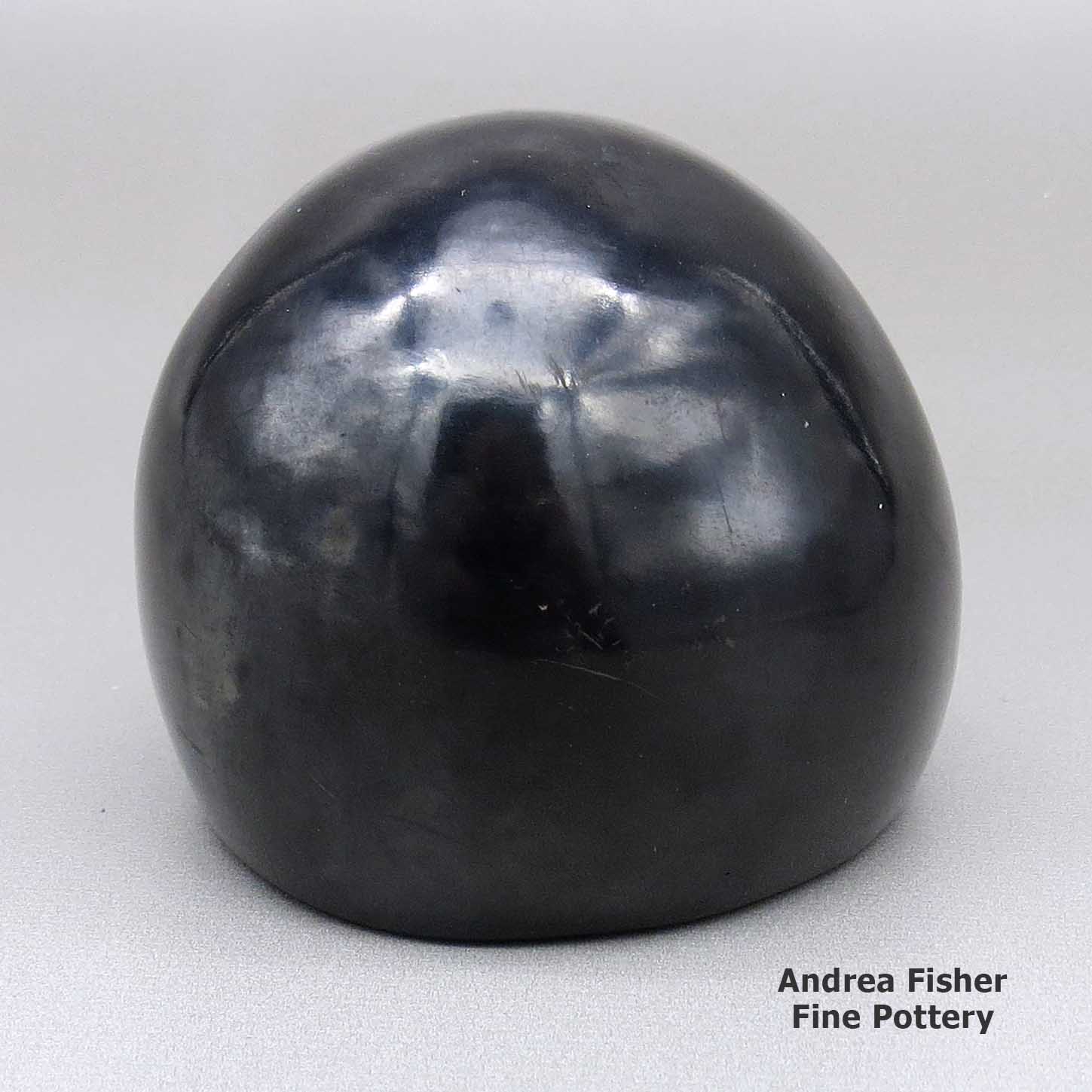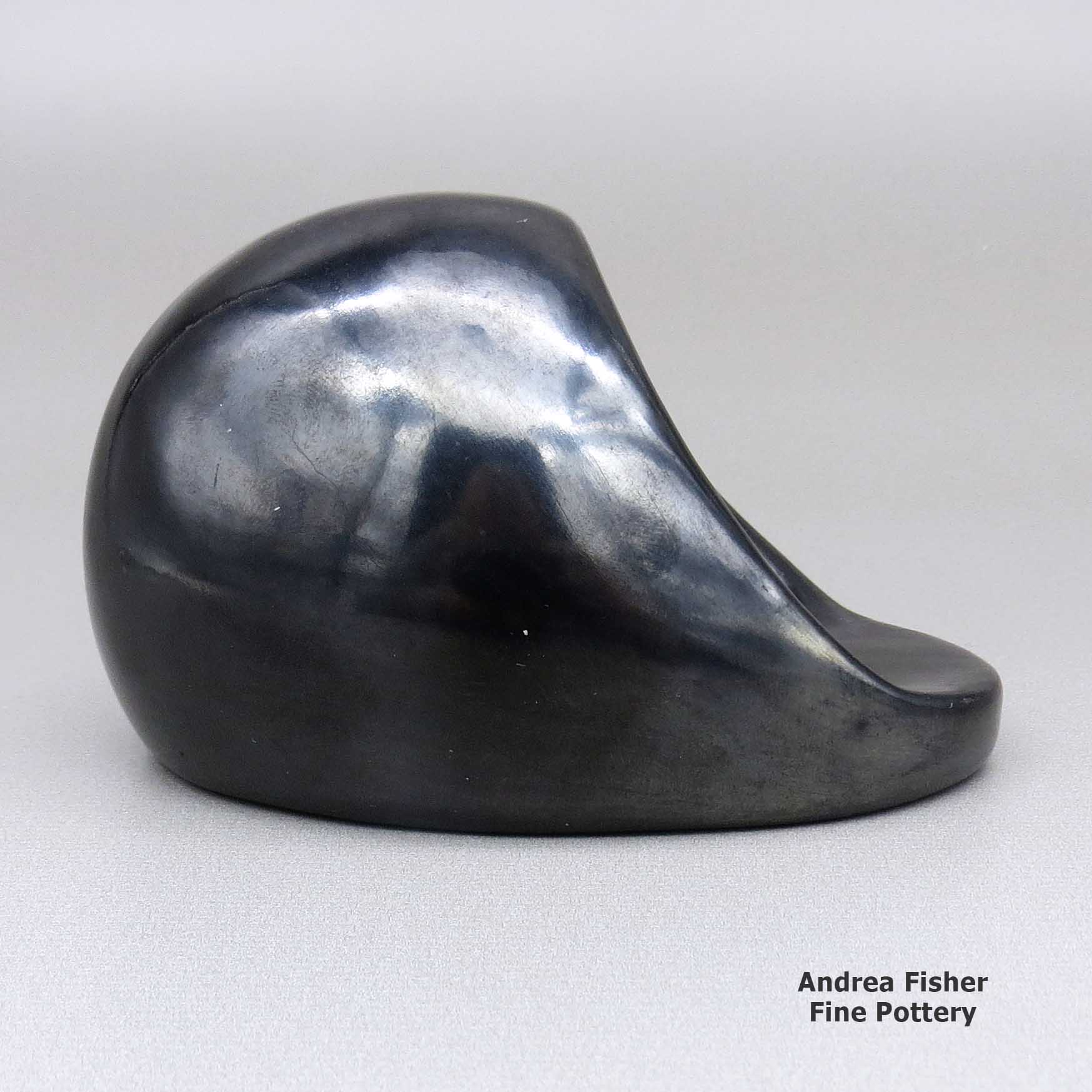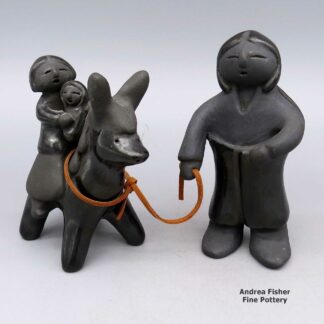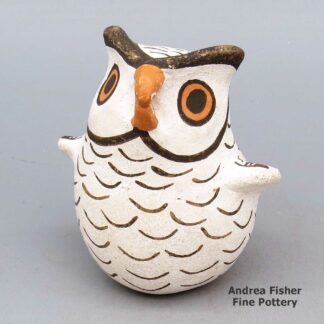| Dimensions | 4 × 3 × 2.5 in |
|---|---|
| Condition of Piece | Very good, normal wear |
| Date Born | 1943-1956 |
| Signature | Maria Santana |
Maria Martinez, thsi3b011, Polished black horno
$1,100.00
A small polished black horno, a horno is an adobe oven seen most often on a pueblo. Hornos are among the first pieces made by some potters.
In stock
- Product Info
- About the Artist
- Home Village
- Design Source
- About the Shape
- About the Design
- Family Tree
Brand
Martinez, Maria
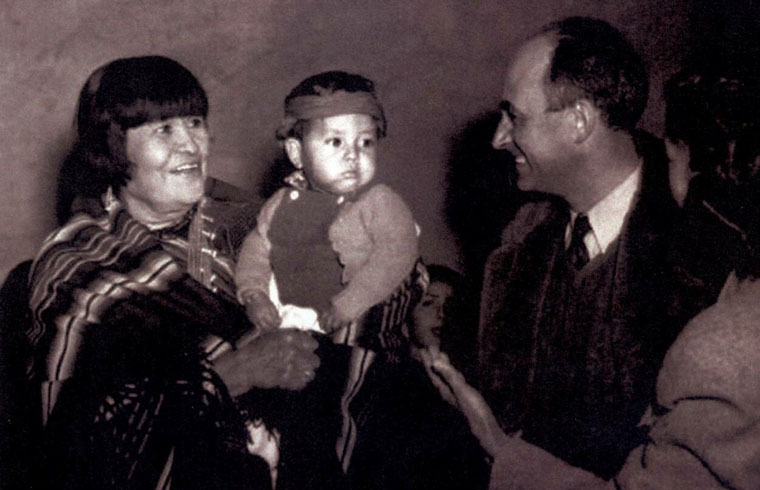 Undoubtedly the world's most famous Native American potter, Maria Montoya Martinez was born in the Tewa pueblo of San Ildefonso around 1887. Back in those days records were maintained by the church and as far as they were concerned, no one was born until they were baptised. Maria's baptism certificate says 1887, she herself thought she might have been 7 by then.
Undoubtedly the world's most famous Native American potter, Maria Montoya Martinez was born in the Tewa pueblo of San Ildefonso around 1887. Back in those days records were maintained by the church and as far as they were concerned, no one was born until they were baptised. Maria's baptism certificate says 1887, she herself thought she might have been 7 by then.As she grew up, Maria observed her aunt, Nicolasa, making pottery. She was very interested and learned the basics of the traditional art of pottery making through watching and working with her.
In the early years of her career, Maria produced the traditional polychrome pottery of her village, generally black and terra cotta decorations painted on a background of white or tan. She shaped her pots the age-old way, by carefully hand-coiling and pinching the clay, then smoothing the inner and outer surfaces with gourd scrapers. However, Maria wasn't happy with her own painting skills so she went to others to have any decorations added.
Early on her pots were recognized as the thinnest and most beautifully shaped pots being made at San Ildefonso. She had no trouble finding painters to decorate her pieces. Then the man who became her husband, Julian Martinez, an accomplished painter of hides, paper and walls, began decorating more and more pots for her. Then he worked with her in the firing of them.
Maria and Julian were married in 1904. From the beginning of their relationship they were traveling to demonstrate their craft at various fairs and expositions. They spent their honeymoon in 1904 demonstrating traditional San Ildefonso pottery making at the Louisiana Purchase Exhibition at the St. Louis Worlds Fair.
They demonstrated their crafts again at the Panama California Expo in San Diego in 1915, the Chicago Worlds Fair in 1934, and the Golden Gate International Expo in 1939.
Native American craft fairs provided other marketing opportunities, and when she began signing her work, Maria both heightened her visibility and commanded higher prices. In 1954, she was awarded the Craftsmanship Medal, the highest honor awarded by the American Institute of Architects.
Contrary to legend implying that Maria "discovered" the black pottery process, Dr. Edgar Lee Hewett, Professor of Archaeology at the University of New Mexico in Albuquerque and Director of the Museum of New Mexico in Santa Fe, found sherds of prehistoric black pottery while excavating in the ruins of Tsankawi (a non-contiguous part of Bandelier National Monument) in 1908. Tsankawi was an ancestral home of the San Ildefonso people.
To preserve and showcase that ancient product, Hewett went to San Ildefonso Pueblo and sought a skilled pueblo potter who could re-create that ancient style for him. Everyone he asked referred him to Maria. Together they worked out a deal and he pre-ordered (and paid for up front) a series of black pots from her.
When he returned, two years later, she had some black pots to show him. She wasn't very happy with them but Hewett and his students were. They bought everything she had, even the ones she'd hidden under her bed. Then they commissioned more and paid for them, again in full and up front.
That led to several years of experimentation, until Maria and Julian were satisfied with their results in not just recreating that style of blackware but in going a step further. Their method required smothering the fire with manure during the firing process, effectively creating an "oxygen-reduction process" that turned the would-be-red pots black.
Julian worked out the other half of the "black-on-black" process when he began painting his designs "in the negative," using a matte black paint on the polished pot surface to create his decorations. Once fired, that demonstrated the technique that has become so famous today.
According to Susan Peterson in The Living Tradition of Maria Martinez, the six distinct steps involved in the creation of blackware pottery include, "finding and collecting the clay, forming a pot, scraping and sanding the pot to remove surface irregularities, applying the iron-bearing slip and burnishing it to a high sheen with a smooth stone, decorating the pot with another slip, and firing the pot."
Julian faced a challenge in attempting to decorate Maria's pots. The process he finally settled on involved polishing the background first and then applying the matte slip to outline the decoration and fill in the background. In 1918, Julian finished their first decorated blackware pot with a matte black background and a polished avanyu (horned water serpent) design. Many of Julian's decorations were patterns adopted from ancient vessels of the pueblos. Some of the patterns consisted of feathers, birds, road runner tracks, deer tracks, rain, clouds, mountains, lightning bolts and kiva steps.
As her pots attracted more and more attention for their unique beauty, Maria began to slowly raise her prices. With the demand for her pots growing, she realized that her work could enrich the lives of the people of her pueblo, artistically and economically.
After the Spanish flu pandemic passed through in 1918-1919, the pueblo was reduced to less than 90 members. Maria's efforts back then virtually saved her people. In the ages-old puebloan manner, she generously shared her techniques with others. Maria became the matriarch of a "craft lineage" that continues today. In a career that spanned seven decades, her pottery brought honors and acclaim, revitalizing the art and the economy of San Ildefonso Pueblo.
Even though Julian decorated the pots, Maria claimed all the work in the early years because pottery was still considered a woman's job in the pueblo. Maria started to sign her pottery with "Marie" in 1922. She signed "Marie" because Kenneth Chapman, Director of the Museum of New Mexico, had convinced her "Marie" was a name more familiar to the Anglo buying public than "Maria" and should command higher prices.
They left Julian's signature off their pieces to respect the norms of Pueblo culture until 1926. Then Maria decided that since Julian was doing half the work, as the painter he should get half the credit. After that, "Marie + Julian" was the official signature on their pottery until Julian's death in 1943.
Maria's family began helping more with the pottery business after Julian died. From 1943 to 1956 Maria's son Adam took over collecting clay and materials for firing while his wife Santana took over painting decorations. "Marie + Santana" was the signature on their pots. These years were also Maria's most prolific years.
Maria's younger son, Popovi Da, spent four years in the US Navy after World War II. In 1950 he returned to San Ildefonso and, at the urging of Maria, began learning to paint with Santana. In 1956 he agreed to do Maria's painting for her. That's when Santana went back to her home and began working with Adam under their name. The signature on Maria's pots became "Maria/Popovi", until 1971 when Popovi passed on. Maria didn't make another piece after his death.
Popovi had also often been busy with tribal politics during those years and, at times, couldn't keep up with painting Maria's pots. As Maria almost never painted a pot, those pots are plain and signed "Maria Poveka" (Poveka being her Tewa name, meaning: "pond lily").
Today, values on Maria's work vary based on the signature on the bottom, those with "Maria + Popovi" being among the most valued of all Pueblo pottery. After making pots for almost 80 years, Maria passed on in 1980.
A Short History of San Ildefonso Pueblo
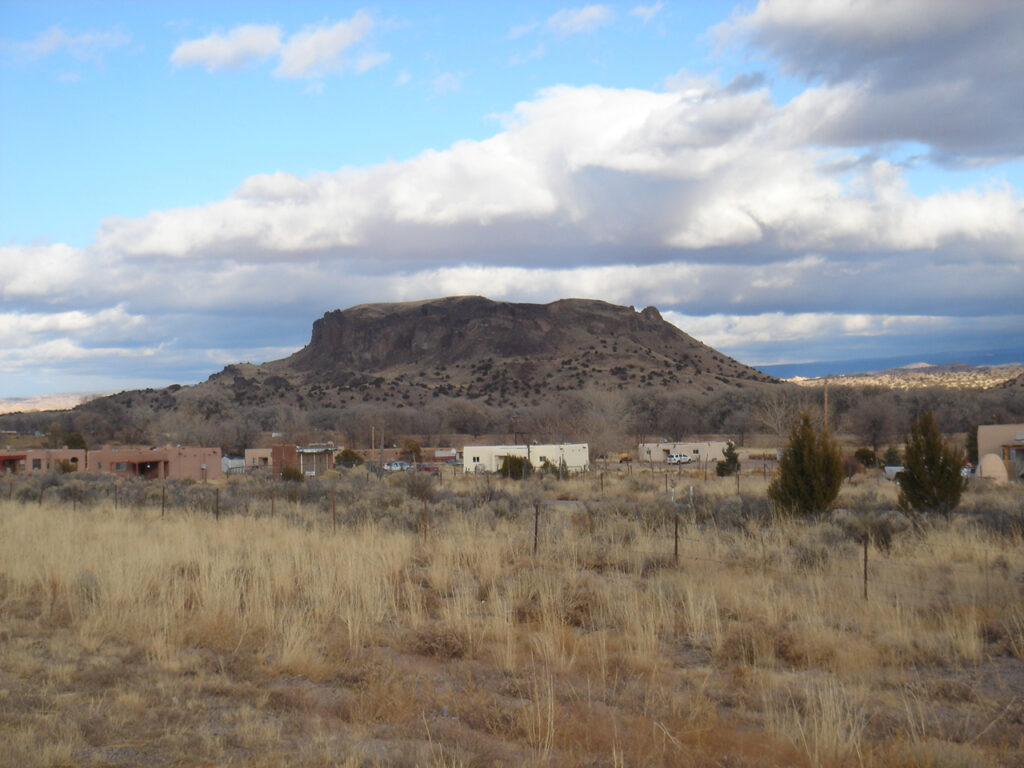
San Ildefonso Pueblo is located about twenty miles northwest of Santa Fe, New Mexico, mostly on the eastern bank of the Rio Grande. Although their ancestry has been traced as far back as abandoned pueblos in the Mesa Verde area in southwestern Colorado, the most recent ancestral home of the people of San Ildefonso is in the area of Bandelier National Monument, the prehistoric village of Tsankawi in particular. The area of Tsankawi abuts today's reservation on its northwest side.
The San Ildefonso name was given to the village in 1617 when a mission church was established. Before then the village was called Powhoge, "where the water cuts through" (in Tewa). The village is at the northern end of the deep and narrow White Rock Canyon of the Rio Grande. Today's pueblo was established as long ago as the 1300s and when the Spanish arrived in 1540 they estimated the village population at about 2,000.
That first village mission was destroyed during the Pueblo Revolt of 1680 and when Don Diego de Vargas returned to reclaim the San Ildefonso area in 1694, he found virtually the entire tribe on top of nearby Black Mesa, along with almost all of the Northern Tewas from the various pueblos in Tewa Basin. After an extended siege, the Tewas and the Spanish negotiated a treaty and the people returned to their villages. However, the next 250 years were not good for any of them.
The Spanish swine flu pandemic of 1918 reduced San Ildefonso's population to about 90. The tribe's population has increased to more than 600 today but the only economic activity available for most on the pueblo involves the creation of art in one form or another. The only other jobs are off-pueblo. San Ildefonso's population is small compared to neighboring Santa Clara Pueblo, but the pueblo maintains its own religious traditions and ceremonial feast days.

Photo is in the public domain
Tewa Design Sources
The Northern Tewa people are mostly from the villages of Ohkay Owingeh, Santa Clara, San Ildefonso, Pojoaque, Nambé and Tesuque. The Hopi-Tewa of Arizona are descendants of the Southern Tewa. The Tewa share a common heritage from back in the 1200s CE, when their ancestors lived in the canyons and valleys west of Mesa Verde. When the Great Drought hit (around 1276 CE), they were already on the move because of other recent bad weather events. The kachina cult was developing around the same time and however it worked out, never took hold among the Tewa. The Tewas did incorporate the Medicine and Sacred Clown societies into their religious activities. Archaeologists have traced their tracks east from the Four Corners to the South San Juan Mountains, where they turned south and first built homes in New Mexico around Ojo Caliente. From there, they spread further south into the valley of the Rio Chama and then spread out there for a hundred years.
As more and more Dineh and Apaches came into the area in the 1400s, the Tewa moved downstream along the Chama. Some of them moved up onto the Pajarito Plateau while others sorted out into small villages on the east side of the Rio Grande. Shortly some of them came to the southern edge of the Santa Fe River Basin and found the Galisteo Creek Basin on the other side populated by Eastern Keres people. It was the same when they came to the mouth of the Santa Fe River at the Rio Grande: further south along the river was populated by other Eastern Keres people. And just upstream across the Rio Grande was the outlet of Frijoles Canyon, home of many Eastern Keres people in the 1400s and 1500s.
There were indigenous Tanoan people already living throughout the Rio Grande area and the two groups merged reasonably well. Somewhere in this time period, sodalities came into being: the Summer People and the Winter People. Some archaeologists believe the incoming Tewa became the Summer People and the Tanoans became the Winter People, based on the fact the incoming Tewas brought new seeds, new agricultural and ceramic technology, new dances and new religion. When the Spanish first arrived in the area around 1540 CE, the Tewa Basin was well occupied by the merged Tewa/Tano people. Those Tanoans who preferred not to merge built separate pueblos for themselves in more marginal areas in the Santa Fe and Galisteo River basins. Depopulation began after the Spanish left and didn't take their various diseases with them. It was after Don Diego de Vargas arrived in 1598 that the survivors were separated into their separate villages and restricted to those.
The Northern Tewa
The Northern Tewa design pallette contains a number of motifs common to many puebloan societies: hummingbirds, turtles, tadpoles, quails, owls, deer, hands, hoof prints, bird tracks and more. It's easy to see how many evolved from designs from the Flower World Complex of central Mexico. The Santa Clara and Nambé avanyu is a winding serpent with usually, one or three feathers on the top of its head. The San Ildefonso avanyu usually has a three- or five-pronged plume on its head. The avanyu itself is evolved from images of Quetzalcoatl. While the avanyu is the protective spirit of water and springs it also represents what happens when there's a heavy rain in the desert: flash floods that can wipe out whole villages.
Most San Ildefonso potters paint their decorations, only a few work with sgraffito decorations and a few work with inlaid stones and heishi beads. At Santa Clara, potters carve, scratch and paint their pieces, then sometimes reheat them with a blowtorch and mount stones on them... almost anything goes. The design palette is traditional to trend-setting contemporary, although the subject matter is usually the avanyu, or hummingbirds, turtles, quails, fish, deer, bear paws and bear claws, etc.
Because they had easy access to micaceous clay, the people of Nambé and Ohkay Owingeh built a brisk business in making micaceous pots and cookware, similarly to the people of Taos and Picuris at the time. More recently, Lonnie Vigil and Robert Vigil have produced micaceous pottery at Nambé while Clarence Cruz has been producing micaceous cookware and utensils at Ohkay Owingeh.
The people of Ohkay Owingeh decided to start over after essentially losing their pottery tradition in the 1800s. They never stopped making utilitarian pottery but even that declined in the late 1800s. In the 1920s, when it was decided they would work to revive a purely Ohkay Owingeh tradition, they settled on the designs found on some prehistoric pottery that had been found while digging in an old Tewa pueblo on Ohkay Owingeh land. The pottery was dated to the few decades before the Spanish arrived, hence: pre-contact and innocent of European influence. Their definition of Potsuwi'i pottery is very specific as to the colors and textures of the clay used and the designs carved, scratched or painted on them. Many of the design patterns are reflective of rock art from a thousand years ago.
The Southern Tewa
The Santa Fe Basin is where the Southern Tewa settled. They seem to have followed the idea that "further south is a better life," and they kept going south until they came up against other relatively entrenched people (migrants spreading out from Santo Domingo into the Galisteo Creek Basin). The Santa Fe Basin showed signs of having been occupied by the Tanoan people off-and-on over the centuries. It was a marginal landscape for farming but it was up against the Cerrillos Hills where they found turquoise, silver and lead ore. The turquoise trade was very profitable for some but the lead ore made possible different design techniques to use on fired pottery. The potters of the village did well producing lead-glazed pottery (not sealed, glazed only where the lead paint was applied and then ran in the heat of the fire).
In 1692, when the Spanish arrived in full force to reconquer northern New Mexico, most of the Tewa people in Tewa Basin gathered atop Black Mesa, a volcanic plug that sits between Santa Clara and San Ildefonso Pueblos. They stayed up there for months, almost impervious to Spanish attack. Eventually, though, they made a deal with the Spanish and returned to their various pueblos.
Shortly after that, the Spanish issued an order limiting access to the lead mines at the Cerrillos Hills to Spanish citizens only and, with that, the Southern Tewa lost their last possibility for remaining in a parched landscape. Because of the boundaries imposed by the Spanish, they all ran north in the night to the area of Chimayo. That didn't work out quickly, so they moved to the area of Santa Clara, again during the night. That didn't work out either as they were challenged by a Spanish priest and they killed him. From there they moved quickly to the area of Zuni, then up to First Mesa where they made a deal with the people of Walpi and were shortly living in their own village near the base of First Mesa. Over the centuries they came to be known as the Hopi-Tewa. In that same time period many of the religious aspects of Hopi society have made their way into Hopi-Tewa society. The Hopi-Tewa design pallette consists mostly of designs revived from potsherds found around the ancient pueblos of Awatovi, Sikyátki, Payupki and Kawaika'a, all of which are in the vicinity of the Hopi mesas.
About Figures and Figurines
Generally, "Figure" denotes a real or mythic creature, like an owl or human or katsina or Corn Maiden. Whether form or decoration, all Puebloan pottery figures are meant to invoke particular spiritual essences. That's why "effigy" is used almost as often as "figure" to denote these pieces.
Among most Puebloans, the figure of an owl, for example, signifies all the physical and spiritual aspects attributed to the owl. It's a form of prayer to the spirit of "Owl" and the appropriately decorated physical form is meant to make that spirit manifest. However, to the Zuni people an owl is a good omen and to the Tewa people, an owl is a bad omen. Some potters at Santa Clara have made owls anyway, they just shaped and decorated them to reflect that "badness."
That explanation may make more sense in the case of the Corn Maiden as she is a mythic entity whose existence revolves around the most ubiquitous food staple in the Puebloan world: corn (maize). All representations of the Corn Maiden are meant to invoke her benevolence and abundance for their people. Because of her mythical/spiritual nature, different pueblos have slightly different physical forms for her but they all incorporate the basic form of a female human face on an ear of corn.
The potters of Tesuque turned out thousands of muna figures (also known as rain gods)for several decades, until they virutally burned out their pottery tradition. These muna had very specific shapes but were decorated with everything from micaceous slips to incised lines to polychrome geometric designs to poster paints. They were also made purely for domestic American consumption, sometimes delivered by the barrel to be used as prizes and giveaways.
The Storyteller is another figure based on Puebloan tradition: a tribal elder singing the stories of the tribe's oral history to the children. The original was based on the traditional cultural story: a grandfather singing his part of the story in his native language so the children learn both the language and their identity against the backdrop of that history. Shortly, the storyteller form was duplicated in several other pueblos, each pueblo's potters adapting the form to their local situation. In some places, the grandmother became the primary sex of their storytellers. At Jemez, that responsibility was shared between grandmothers and grandfathers. Then some potters in search of new niches in the marketplace branched into making "spirit figure" storytellers, like eagles, ravens, hummingbirds, cats and dogs. Some Zuni potters have made storyteller owls.
Similar to the Storyteller is the Story Time: a set of separate children displayed around a larger central singing figure.
The Nativity set (also known as nacimiento) is a set of figures based on the intersection of Puebloan mythologies and stories they heard from Christian missionaries. Those potters who make them also tend to favor dress, shapes and designs that reflect their own heritage(s). The first few nativities made at Tesuque Pueblo were decorated with Spanish colonial costumes but that soon changed and every nativity made since has a distinct blend of Native American and Christian, with no other reference to colonialism. The "Singing Angel" (a single standing figure with outstretched wings and hands clasped together in prayer) and "Flight to Egypt" (usually depicting Mary with a baby Jesus on the back of a donkey and a standing Joseph nearby holding the rein) are similar mixes of tribal and Christian figures. The miniature nativities made by Santa Clara/Dineh artist Linda Askan clearly show Dineh religious influence in the headresses worn by Joseph, the angel and the three wise men. At the same time, the Dineh Folk Art nativities made by Jonathan Chee are based on the realities of daily Dineh life: the three wise men wear wide-brim hats and blue jeans, and bring gifts of salt and 50-pound bags of flour.
Pueblo and Dineh artists also make a full zoo of domesticated, farm and wild animal figures: horses, donkeys, cows, chickens, pigs, sheep, turkeys, giraffes, elephants, dogs, cats, mermaids, women-dressed-up-and-taking-selfies and cowboys among them.
About the Horno
In most southwestern Native American villages you'll find hornos built in the yards, right outside the main doors to people's homes. A horno is a dome-shaped adobe construction with a wide opening and hollow interior in the upper half and a fire box in the lower half, its entry on the opposite side from the oven opening. Hornos are used primarily for baking and they tend to be large enough to bake for several families at once. Some potters also fire their pots in their hornos.
The shape of the horno is simple enough and elegant enough that some young potters show how serious they are to learn by going through the steps to making one, almost hand-in-hand with their mentor(s). It teaches the younger potters about the properties of their clay, how to form it, shape it, scrape it, sand it and polish it. In the Tewa pueblos, once their piece is dry enough they often then slip it with an iron-bearing slip that will turn black when they fire it and then smother the fire with powdered manure to create an oxygen-reduction atmosphere. Potters from Jemez and Santo Domingo tend to make polychrome hornos (which usually require some other basic design work, too). The clay has to be perfect, the timing of the process has to be right, the pieces made just enough thick and then dried just right. The weather on firing day has to be just right, etc. And they need to be uttering the correct prayers throughout the process. It's all the basics of the ancient way rolled into one simple piece.
Maria Martinez Family Tree - San Ildefonso Pueblo
Disclaimer: This "family tree" is a best effort on our part to determine who the potters are in this family and arrange them in a generational order. The general information available is questionable so we have tried to show each of these diagrams to living members of each family to get their input and approval, too. This diagram is subject to change should we get better info.
- Reyes Peña (d. 1909) & Tomas Montoya (d. 1914)
- Maria Montoya Martinez (1887-1980) & Julian Martinez (1884-1943)
- Adam Martinez (1903-2000) & Santana Roybal Martinez (1909-2002)
- George Martinez (1943-) & Pauline Martinez (Santa Clara)(1950-)
- Anita Martinez (d. 1992) & Pino Martinez
- Barbara Tahn-Moo-Whe Gonzales (1947-) & Robert Gonzales
- Aaron Gonzales (1971-)
- Brandon Gonzales (1983-)
- Cavan Gonzales (1970-)
- Derek Gonzales (1986-)
- Kathy Wan Povi Sanchez (1950-) & Gilbert Sanchez (San Juan)
- Corrine Sanchez
- Gilbert Abel Sanchez
- Liana Sanchez
- Wayland Sanchez
- Evelyn Than-Povi Garcia
- Myra Garcia
- Berlinda Garcia
- Myra Garcia
- Peter Pino
- Barbara Tahn-Moo-Whe Gonzales (1947-) & Robert Gonzales
- Viola Martinez/Sunset Cruz & Johnnie Cruz Sr.
- Beverly Martinez (1960-1987)
- Marvin Martinez (1964-) & Frances Martinez
- Johnnie Cruz Jr. (1975-)
- George Martinez (1943-) & Pauline Martinez (Santa Clara)(1950-)
- Popovi Da (1921-1971) & Anita Da
- Tony Da (1940-2008)
- Adam Martinez (1903-2000) & Santana Roybal Martinez (1909-2002)
- Desideria Montoya (1889-1982)
- Maximiliana Montoya (1885-1955) & Cresencio Martinez (1879-1918)
- Juanita Vigil (1898-1933) & Romando Vigil (1902-1978)
- Carmelita Vigil (1925-1999) & Nicholas Cata
- Martha Appleleaf (1950-)
- Erik Fender (1970-)
- Gloria Maxey (d. 1999)
- Angelina Maxey (1970-)
- Jessie Maxey (1972-)
- Martha Appleleaf (1950-)
- Carmelita Vigil Dunlap (1925-1999) & Carlos Dunlap (d. 1971)
- Carlos Sunrise Dunlap (1958-1981)
- Cynthia Star Flower Dunlap (1959-)
- Jeannie Mountain Flower Dunlap (1953-)
- Linda Dunlap (1955-)
- Carmelita Vigil (1925-1999) & Nicholas Cata
- Maria Montoya Martinez (1887-1980) & Julian Martinez (1884-1943)


